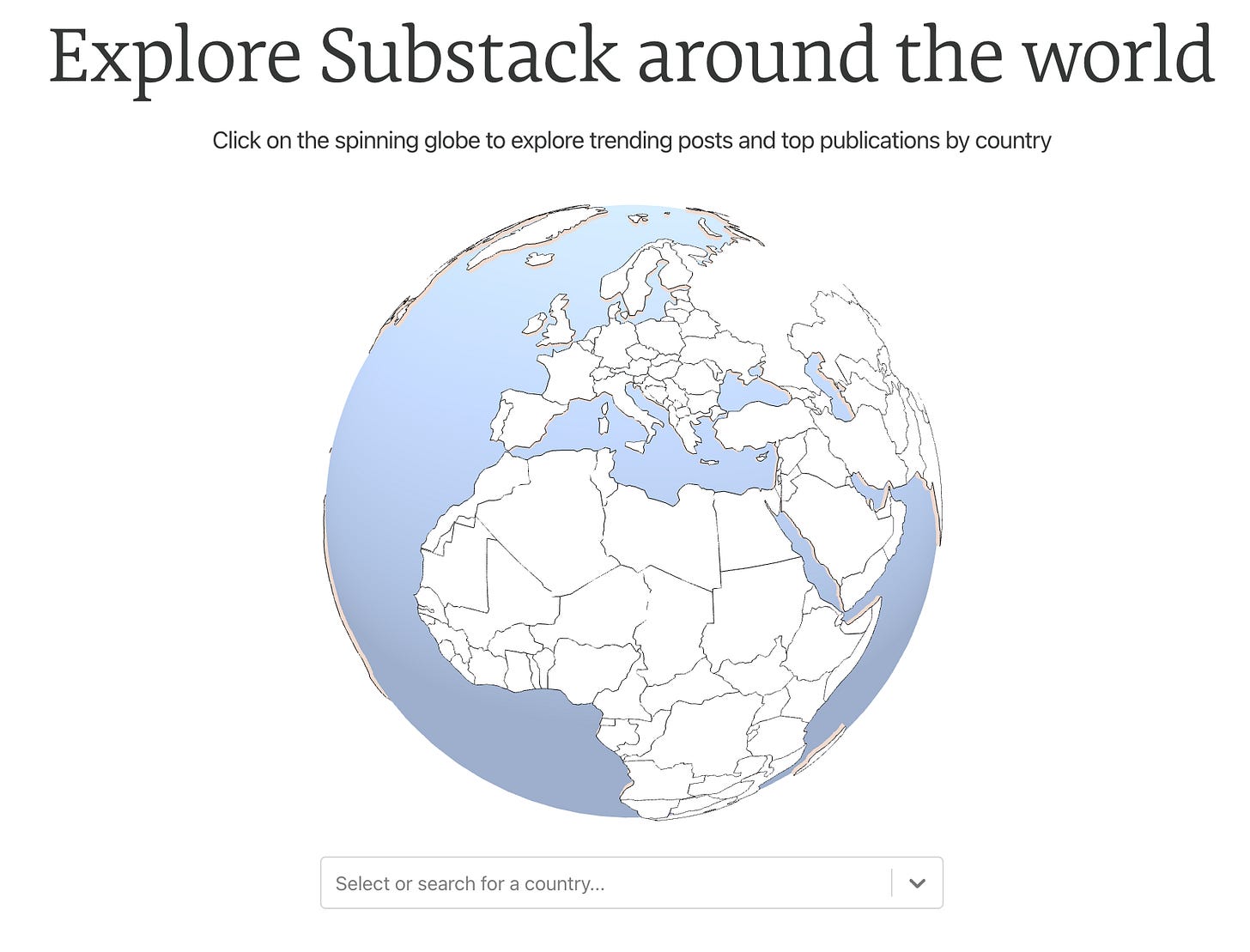Politics And Substack - Part 2: Global And European Approach
Substack has exploded in the US and English-speaking markets. It is still small, but growing, in Europe and internationally.
💬 Quick CONVERSATION STARTERS:
Substack’s boots on the ground around the world and Substack in the UK, Germany, France
What’s the state of Substack in Europe? We spoke to Francesco Oggiano in Italy, Jesús Terrés in Spain, and Lili Barbery in France
Why is there so little data about Substack internationally?
All of what we’ve described in PART 1 of our mini-series Politics and Substack pertains quasi-exclusively to the United States market, relating to American politics mostly.
PART 1 featured:
a very interesting to
bya bit of background about star Substacker
and his work with and SubstackGovernor
launch on Substack, our list of politicians and politicos on the platform — which now also includes Governor Wes Moore — and the amazing work Substack is doing in the area of politics and news thanks toand much more…
While Substack’s creators and readers are not only US-based, it’s unclear what Substack international markets look like right now.
For example, according to the London-based Press Gazette, as of January 2025, “by far the top-performing genre among the 52 accounts we know to be earning at least $500,000 is US Politics.”
As the table below shows, US Politics accounts for £14.9 million ($18.4 million), or 46%, of the £32.6 million minimum the group earn each year.
Substack told The Wall Street Journal in January that the top ten accounts on the platform alone collectively earn $40 million a year.
But the data represents the whole of Substack — accounting for both the US market (by far the biggest) and all international markets.
Back in 2021, Substack seemed to have gone through a push towards global — or should we say glocal? — markets and launched Substack Local, a $1 million initiative to help independent writers start sustainable local news enterprises globally.
Among the winners, 6 were from outside of the US:
- , author of (Iași, Romania)
- , author of — formerly West Africa Weekly (Nigeria)
- , author of (São Paulo, Brazil)
- , publisher and founder of , , and (Manchester, Sheffield, and Liverpool, UK)
Michelle Kuo and
, authors of (Taipei, Taiwan)- , author of Murray Bridge News (Murray Bridge, Australia)
Fast forward to 2024, Substack has started to invest a bit more heavily in its international markets and launched a few new tools:
Substack has implemented pricing in 13 different currencies
New subscribers in Europe can pay for their subscription using alternative methods
For writers who publish in Spanish, French, Italian, German, or Portuguese, you can select one of these languages as the default language for your Substack experience
“We’re encouraged to see that new readers around the world are discovering writers and supporting them directly,” Substack said in launching these new tools. “We hope these new features will continue to foster those connections.”
And just last month, Hamish was at SXSW London. In his interview on stage with
of the , he talked about how Substack is empowering a new wave of independent voices and what he calls “the new possibilities that Substack opens up for writers.”While the SXSW London interview was not recorded, here’s a recap from Emma. And here another recap by
.Traffick Substack generates internationally
The following is not official Substack data. It is aggregated data from Semrush, SimilarWeb, and WMTips, as of May 2025, compiled by ChatGPT… So take this for what it is:
The United States represents a majority share, hovering between 54%–63% depending on the data source.
Other English-speaking countries—the UK, Canada, and Australia—collectively contribute around 12%–18% of the global audience.
India shows modest traffic, around 2–3%.
The remaining 20%–35% of the audience comes from other countries: European nations, Latin America (e.g., Brazil), Asia, etc.
Insights about Europe, including the UK:
The UK leads European engagement, making up roughly 8 % of Substack’s site usage.
Southern and Western Europe (e.g., Italy, Germany, France, Netherlands) individually contribute 2–3 % each.
Combined, these six European countries total approximately 17–18 % of Substack’s ecosystem presence.
Substack’s boots on the ground around the world
Also, since 2021, Substack has started to hire local staffers in Europe and elsewhere:
- — in the UK
- in Germany (since 2023)
- in France (since February 2024)
- in Australia (March 2024 - October 2024)
What about Italy? (I personally know several great Substackers there who are nurturing an amazing Substack community, but sadly no Substack staffer on the ground yet)
Spain? (same, no Substack staffer yet)
And what about Brussels and the so-called Brussels Bubble? (European politics is certainly a hot topic in Brussels and throughout Europe, but again, no Substack staffer with boots on the ground)
Substack in the UK and internationally
Anyhow, here’s something Farrah wrote last year about Substack in the UK and internationally:
Some of Britain’s most revered writers and culture makers have found their way to Substack:
, author , journalist , and superstar philosopher , to name just a few. But also—and this is the bit that especially excites me—thousands of lesser-known names showed up, putting their creative hearts on the line and in the process finding a new global audience.Connecting culture makers across the world is something we’ve been thinking about a lot at Substack.
Farrah gave also a few examples of Substack meetups in Amsterdam, London, Berlin, Paris, and Dublin.
For example, the launch of Substack in France was quite recent, in April 2024. “Merci La France for the warmest reception,” Substack wrote on Instagram.
Sustack in France — or rather, in French…
Well, lot’s happening in France…
Just recently, Substack co-founder Hamish was in Paris for what
called “a little dinatoire” to meet writers and creators. Dorie said about the soiree: “Thank you, Substack for giving my work a home and for creating such a splendid international community.”Apparently, in Paris, Hamish also had lunch with
of . Here’s a recap.And last week, journalist
called Substack a “OnlyFans for the brain” and “of ideas” in an article examining how French-language Substack is performing.She also addressed politics and political discourse, and said: “Don't get me wrong: on Substack, there are right-wing ideas and there are left-wing ideas, it's like everywhere else. The advantage is that authors have more space to support their thinking.”
In her article Rose-Aimée brings a few examples from French language Substackers in Canada, like
and . She also mentioned Canadian-born reporter and news personality .Danessa told Rose-Aimée: “We're told that people no longer want to pay for their information, but that's not true! They want the content they pay for to meet their needs. People pay me more than if I wrote columns in traditional media.”
Geneviève pointed out: “I want to be in discussion and reflection rather than confrontation and that's what I saw on Substack.”
Substack in Germany
As for Germany, Alex Laux told OMR in July 2024 that “Germany is the third market after the US and UK because there has already been considerable organic interest here.”
He gave some examples:
and . And he added: “If you're one of the top publications on Substack in Germany, we're already talking about six-figure annual revenues.”Alex told Medien Insider in August last year: “With the launch in Germany, there's even more support from Substack. We want to sharpen the message, the offering, and raise awareness around the service. We want to convince authors to use Substack with broad initiatives. […] But what's especially important to me is that the community is thirsting for more networking, and we want to help with that."
Politics is certainly big in Germany and Alex told Medien Insider: “My vision: In one to two years, the future Chancellor will announce new political measures on their Substack, which will then be picked up by the Tagesschau news program — instead of doing it via social platforms.”
So far however, the new Chancellor, Friedrich Merz, has not debuted on Substack.
Substack around the world
As Substack’s global map shows, Substack is (almost) everywhere around the world.
What’s the state of Substack in Europe?
We asked a few Substackers in Italy, Spain, and France…
Here’s what , author of , told us about Substack in Italy and in Europe:
I believe that in Italy too, more and more journalists and news creators are looking for a place to cultivate their own audience — and above all, a clean, non-toxic dialogue with that audience, free from the toxicity that is sometimes found on social media and unaffected by algorithmic conditioning.
A platform like Substack is proving to be the best tool for this, both because of its easy user experience and its virtually nonexistent entry barriers.
Just last week, I helped two very talented colleagues launch their own vertical newsletters on their respective areas of expertise (football for one, and Milan City politics for the other).
Of course, there are challenges. At the moment, I see at least two:
The difficulty of (solid but) slow growth. Newsletters may be the easiest medium to launch, but arguably the hardest to sustain: they require consistency and effort, with results that only appear over the long — sometimes very long — term.
The transformation of a space like Substack, which — to me — seems to be shifting more and more from being about newsletters to becoming a social media platform (see features like Notes, the push towards the app, etc.). This is causing several authors to migrate toward more alternative newsletter platforms.
Still, as far as I’m concerned, starting a newsletter remains the most fulfilling professional choice I’ve made in recent years :)
This is what , author of and contributor to Vanity Fair and Conde Nast Traveler, told us about Substack in Spain:
I launched my newsletter, importa, in March 2020. It currently has 39,000 subscribers to the free version.
At that time, there were hardly any newsletters on this platform in Spain, and I was one of the first to try the paid subscription model.
The last financial year (2024 and 2025) has seen the sector explode in Spain. There are more and more newsletters, and I would say that we are approaching a bubble, just as it happened with podcasts. I suppose the same thing happens with all channels that become trendy. After this bubble bursts, I think there will be a stabilization.
We reached out to , author of the Lili Barbery Substack, and here is what she told us about Substack in France:
Substack is still very little known in France. It’s an incredible tool that allows me to send newsletters to a community I’ve built over the past 15 years, but also to communicate directly with this community through chat or interact via Lives. I feel more comfortable sharing more personal content there because the people who follow me have chosen to subscribe to receive my emails. Since monetizing my newsletter starting in October 2024 (my newsletter had existed well before that—it was free and I sent it using the Brevo software), I’ve converted a large number of subscribers to the paid format, which provides financial support that allows me to prioritize writing my newsletter over other professional activities. I’m also amazed by the quality of their AI tools, which help authors promote their work on other platforms, whether it’s their newsletters or a live session.
On the other hand, I’m facing several issues with Substack. First, I find the app very hard to follow and understand. I don’t quite get what Substack is trying to do with the “Notes” feature, which can include text, photos, and videos, as if it’s trying to be Twitter, Instagram, and TikTok all at once. So far, posting Notes has done absolutely nothing to help me gain new subscribers. The app is not user-friendly at all. My community complains about it constantly—and I understand them. Also, all the settings are in English for now, and a large number of my readers feel lost to the point that some even unsubscribe because of this. Moreover, the platform automatically subscribes new users to a whole bunch of email content, which I find unbearable. Our audience shouldn’t be used as a marketing tool by Substack, especially when they’re paying for a subscription and don’t want to receive even more emails each week. Of course, you can unsubscribe from this content, but since everything is in English, it’s more complex for French-language subscribers.
One other issue I find problematic: I chose to transfer all the content from my website lilibarbery.com to lilibarbery.substack.com in order to make over 1,500 archived articles accessible via paid subscription. On a browser, my Substack looks beautiful—it meets my expectations. On the app, however, my artistic direction is lost, and my content just looks awful.
I’ve raised all of these concerns with the Substack team, but for now, they have no solutions to offer.
The platform is still young—we’ll see if it manages to overcome these challenges in the future.
What’s next for Substack in Europe?
To be truly embedded into the global political discourse, Substack needs to branch out, but most importantly grow in other markets, including Europe.
Mentioning a recent article Nieman Journalism Lab article reporting the launch of
and on Substack, London-based The Fix explained “this trend seems still new in Europe.” Here are their takeaways:“This was news to us! We haven't considered Substack as a newsletter platform for our own newsletters,” James Savage, publisher and CEO of The Local told The Fix.
So far, The Daily Mail seems to be the only big-name legacy publisher in Europe present on Substack.
“I really like Substack, but it's probably better if you're not a publication but a single blogger who wants to focus on writing articles,” Philippe Kramer, co-founder of The European Correspondent, told The Fix.
The Fix said that ,“in recent months, Substack's rival Ghost has become more popular, notably due to its lower costs: only charging a flat fee based on audience size, compared to 10 percent of the subscription revenue for Substack.”










